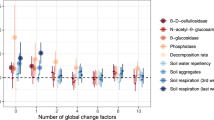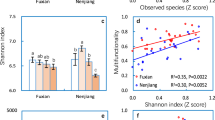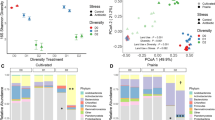Abstract
Soil ecosystems worldwide are subjected to marked modifications caused by anthropogenic disturbances and global climate change, resulting in microbial diversity loss and alteration of ecosystem functions. Despite the paucity of studies, restoration ecology provides an appropriate framework for testing the potential of manipulating soil microbial communities for the recovery of ecosystem functioning. We used a reciprocal transplant design in experimentally altered microbial communities to investigate the effectiveness of introducing microbial communities in degraded soil ecosystems to restore N-cycle functioning. Microbial diversity loss resulted in alternative compositional states associated with impaired N-cycle functioning. Here, the addition of complex microbial communities to these altered communities revealed a pivotal role of deterministic community assembly processes. The diversity of some alternative compositional states was successfully increased but without significant restoration of soil N-cycle functioning. However, in the most degraded alternative state, the introduction of new microbial communities caused an overall decrease in phylogenetic diversity and richness. The successful soil colonization by newly introduced species for some compositional states indicates that priority effects could be overridden when attempting to manipulate microbial communities for soil restoration. Altogether, our result showed consistent patterns within restoration treatments with minor idiosyncratic effects. This suggests the predominance of deterministic processes and the predictability of restoration trajectories, which could be used to guide the effective management of microbial community assemblages for ecological restoration of soils.
Similar content being viewed by others
Log in or create a free account to read this content
Gain free access to this article, as well as selected content from this journal and more on nature.com
or
References
Bardgett RD, van der Putten WH . (2014). Belowground biodiversity and ecosystem functioning. Nature 515: 505–511.
Berry D, Ben Mahfoudh K, Wagner M, Loy A . (2011). Barcoded primers used in multiplex amplicon pyrosequencing bias amplification. Appl Environ Microbiol 77: 7846–7849.
Bonebakker RG, Liaw WHA, Lumley T, Maechler M, Magnusson A, Moeller S et al. (2012). R package 'gplots' version 3.0.1.
Bru D, Ramette A, Saby NP, Dequiedt S, Ranjard L, Jolivet C et al. (2011). Determinants of the distribution of nitrogen-cycling microbial communities at the landscape scale. Isme J 5: 532–542.
Caporaso JG, Bittinger K, Bushman FD, DeSantis TZ, Andersen GL, Knight R . (2010a). PyNAST: a flexible tool for aligning sequences to a template alignment. Bioinformatics 26: 266–267.
Caporaso JG, Kuczynski J, Stombaugh J, Bittinger K, Bushman FD, Costello EK et al. (2010b). QIIME allows analysis of high-throughput community sequencing data. Nat Methods 7: 335–336.
Chase JM . (2003). Community assembly: when should history matter? Oecologia 136: 489–498.
Commission of the European Community. (2006). Proposal for a directive of the European parliament and of the council establishing a framework for the protection of soil and amending directive.
Csardi G, Nepusz T . (2006). The igraph software package for complex network research. Int J Complex Syst 1695: 1–9.
Delmont TO, Francioli D, Jacquesson S, Laoudi S, Mathieu A, Nesme J et al. (2014). Microbial community development and unseen diversity recovery in inoculated sterile soil. Biol Fertil Soils 50: 1069–1076.
Edgar RC . (2010). Search and clustering orders of magnitude faster than BLAST. Bioinformatics 26: 2460–2461.
Faith DP . (1992). Conservation evaluation and phylogenetic diversity. Biol Conserv 61: 1–10.
Falkowski PG, Fenchel T, Delong EF . (2008). The microbial engines that drive Earth's biogeochemical cycles. Science 320: 1034–1039.
Fox J, Weisberg S . (2011). An {R} Companion to Applied Regression, Second Edition. Sage: Thousand Oaks, CA, USA. Available from http://socserv.socsci.mcmaster.ca/jfox/Books/Companion.
Fukami T . (2015). Historical contingency in community assembly: Integrating niches, species pools and priority effects. Annu Rev Ecol Evol Syst 46: 1–23.
Griffiths BS, Ritz K, Wheatley R, Kuan HL, Boag B, Christensen S et al. (2001). An examination of the biodiversity-ecosystem function relationship in arable soil microbial communities. Soil Biol Biochem 33: 1713–1722.
Harris J . (2009). Soil microbial communities and restoration ecology: facilitators or followers? Science 325: 573–574.
Heneghan L, Miller SP, Baer S, Callaham MA Jr, Montgomery J, Pavao-Zuckerman M et al. (2008). Integrating soil ecological knowledge into restoration management. Restor Ecol 16: 608–617.
Henry S, Baudoin E, Lopez-Gutierrez JC, Martin-Laurent F, Brauman A, Philippot L . (2004). Quantification of denitrifying bacteria in soils by nirK gene targeted real-time PCR. J Microbiol Methods 59: 327–335.
Henry S, Bru D, Stres B, Hallet S, Philippot L . (2006). Quantitative detection of the nosZ gene, encoding nitrous oxide reductase, and comparison of the abundances of 16S rRNA, narG, nirK, and nosZ genes in soils. Appl Environ Microbiol 72: 5181–5189.
Isbell F, Tilman D, Polasky S, Binder S, Hawthorne P . (2013). Low biodiversity state persists two decades after cessation of nutrient enrichment. Ecol Lett 16: 454–460.
Jiang L, Tan J, Pu Z . (2010). An experimental test of Darwin's naturalization hypothesis. Am Nat 175: 415–423.
Kardol P, Van der Wal A, Martijn Bezemer T, de Boer W, Duyts H, Holtkamp R et al. (2008). Restoration of species-rich grasslands on ex-arable land: Seed addition outweighs soil fertility reduction. Biol Conserv 141: 2208–2217.
Kardol P, Wardle DA . (2010). How understanding aboveground-belowground linkages can assist restoration ecology. Trends Ecol Evol 25: 670–679.
Klaus B, Strimmer K, Strimmer MK . (2014). R package 'fdrtool' version 1.2.15.
Laughlin DC . (2014). Applying trait-based models to achieve functional targets for theory-driven ecological restoration. Ecol Lett 17: 771–784.
Legendre P, De Caceres M . (2013). Beta diversity as the variance of community data: dissimilarity coefficients and partitioning. Ecol Lett 16: 951–963.
Leininger S, Urich T, Schloter M, Schwark L, Qi J, Nicol GW et al. (2006). Archaea predominate among ammonia-oxidizing prokaryotes in soils. Nature 442: 806–809.
Lozupone C, Knight R . (2005). UniFrac: a new phylogenetic method for comparing microbial communities. Appl Environ Microbiol 71: 8228–8235.
Martorell C, Freckleton RP . (2014). Testing the roles of competition, facilitation and stochasticity on community structure in a species-rich assemblage. J Ecol 102: 74–85.
Moreno-Mateos D, Power ME, Comin FA, Yockteng R . (2012). Structural and functional loss in restored wetland ecosystems. PLoS Biol 10: e1001247.
Muyzer G, de Waal EC, Uitterlinden AG . (1993). Profiling of complex microbial populations by denaturing gradient gel electrophoresis analysis of polymerase chain reaction-amplified genes coding for 16S rRNA. Appl Environ Microbiol 59: 695–700.
Nemergut DR, Schmidt SK, Fukami T, O'Neill SP, Bilinski TM, Stanish LF et al. (2013). Patterns and processes of microbial community assembly. Microbiol Mol Biol Rev 77: 342–356.
Nemergut DR, Shade A, Violle C . (2014). When, where and how does microbial community composition matter? Front Microbiol 5: 497.
Neuwirth E . (2011). RColorBrewer: ColorBrewer palettes. R package version: 1.0-5.
Ochsenreiter T, Selezi D, Quaiser A, Bonch-Osmolovskaya L, Schleper C . (2003). Diversity and abundance of Crenarchaeota in terrestrial habitats studied by 16S RNA surveys and real time PCR. Environ Microbiol 5: 787–797.
Oksanen J, Blanchet FG, Kindt R, Legendre P, Minchin PR, O'Hara R et al. (2013). vegan: Community Ecology Package. R package version 2.0-3. 2012.
Peter H, Beier S, Bertilsson S, Lindstrom ES, Langenheder S, Tranvik LJ . (2011). Function-specific response to depletion of microbial diversity. Isme J 5: 351–361.
Petric I, Philippot L, Abbate C, Bispo A, Chesnot T, Hallin S et al. (2011). Inter-laboratory evaluation of the ISO standard 11063 ‘Soil quality—Method to directly extract DNA from soil samples’. J Microbiol Methods 84: 454–460.
Philippot L, Spor A, Henault C, Bru D, Bizouard F, Jones CM et al. (2013). Loss in microbial diversity affects nitrogen cycling in soil. Isme J 7: 1609–1619.
Price MN, Dehal PS, Arkin AP . (2009). FastTree: computing large minimum evolution trees with profiles instead of a distance matrix. Mol Biol Evol 26: 1641–1650.
Requena N, Perez-Solis E, Azcon-Aguilar C, Jeffries P, Barea JM . (2001). Management of indigenous plant-microbe symbioses aids restoration of desertified ecosystems. Appl Environ Microbiol 67: 495–498.
Rillig MC, Antonovics J, Caruso T, Lehmann A, Powell JR, Veresoglou SD et al. (2015). Interchange of entire communities: microbial community coalescence. Trends Ecol Evol 30: 470–476.
Rockstrom J, Steffen W, Noone K, Persson A, Chapin FS 3rd, Lambin EF et al. (2009). A safe operating space for humanity. Nature 461: 472–475.
Schimel JP, Schaeffer SM . (2012). Microbial control over carbon cycling in soil. Front Microbiol 3: 348.
Schloss PD, Westcott SL, Ryabin T, Hall JR, Hartmann M, Hollister EB et al. (2009). Introducing mothur: open-source, platform-independent, community-supported software for describing and comparing microbial communities. Appl Environ Microbiol 75: 7537–7541.
Schoch CL, Seifert KA, Huhndorf S, Robert V, Spouge JL, Levesque CA et al. (2012). Nuclear ribosomal internal transcribed spacer (ITS) region as a universal DNA barcode marker for Fungi. Proc Natl Acad Sci USA 109: 6241–6246.
Smith MR, Charvat I, Jacobson RL . (1998). Arbuscular mycorrhizae promote establishment of prairie species in a tallgrass prairie restoration. Can J Bot 76: 1947–1954.
Smith RS, Shiel RS, Bardgett RD, Millward D, Corkhill P, Rolph G et al. (2003). Soil microbial community, fertility, vegetation and diversity as targets in the restoration management of a meadow grassland. J Appl Ecol 40: 51–64.
Stone EA, Ayroles JF . (2009). Modulated modularity clustering as an exploratory tool for functional genomic inference. PLoS Genet 5: e1000479.
Suding KN, Gross KL, Houseman GR . (2004). Alternative states and positive feedbacks in restoration ecology. Trends Ecol Evol 19: 46–53.
Tan J, Pu Z, Ryberg WA, Jiang L . (2012). Species phylogenetic relatedness, priority effects and ecosystem functioning. Ecology 93: 1164–1172.
Tibshirani R, Hastie T, Narasimhan B, Chu G . (2002). Diagnosis of multiple cancer types by shrunken centroids of gene expression. Proc Natl Acad Sci USA 99: 6567–6572.
Tilman D . (2004). Niche tradeoffs, neutrality, and community structure: a stochastic theory of resource competition, invasion, and community assembly. Proc Natl Acad Sci USA 101: 10854–10861.
Tourna M, Freitag TE, Nicol GW, Prosser JI . (2008). Growth, activity and temperature responses of ammonia-oxidizing archaea and bacteria in soil microcosms. Environ Microbiol 10: 1357–1364.
Van Elsas JD, Chiurazzi M, Mallon CA, Elhottova D, Kristufek V, Salles JF . (2012). Microbial diversity determines the invasion of soil by a bacterial pathogen. Proc Natl Acad Sci USA 109: 1159–1164.
Vannette RL, Fukami T . (2014). Historical contingency in species interactions: towards niche-based predictions. Ecol Lett 17: 115–124.
Wagg C, Bender SF, Widmer F, van der Heijden MG . (2014). Soil biodiversity and soil community composition determine ecosystem multifunctionality. Proc Natl Acad Sci USA 111: 5266–5270.
Young TP, Petersen DA, Clary JJ . (2005). The ecology of restoration: historical links, emerging issues and unexplored realms. Ecol Lett 8: 662–673.
Acknowledgements
The sequences of genes reported in this paper are available at NCBI SRA under the accession number SRP057201. This research was supported by the European Commission within the EcoFINDERS project (FP7-264465) and the Conseil Régional de Bourgogne. In memory of Diana Nemergut.
Author information
Authors and Affiliations
Corresponding author
Ethics declarations
Competing interests
The authors declare no conflict of interest.
Additional information
Supplementary Information accompanies this paper on The ISME Journal website
Supplementary information
Rights and permissions
About this article
Cite this article
Calderón, K., Spor, A., Breuil, MC. et al. Effectiveness of ecological rescue for altered soil microbial communities and functions. ISME J 11, 272–283 (2017). https://doi.org/10.1038/ismej.2016.86
Received:
Revised:
Accepted:
Published:
Issue date:
DOI: https://doi.org/10.1038/ismej.2016.86
This article is cited by
-
Soil micro-food web composition determines soil fertility and crop growth
Soil Ecology Letters (2025)
-
Protorhabditis nematodes and pathogen-antagonistic bacteria interactively promote plant health
Microbiome (2024)
-
Root Exudates Modulate Rhizosphere Microbial Communities during the Interaction of Pseudomonas chlororaphis, β-Aminobutyric Acid, and Botrytis Cinerea in Tomato Plants
Journal of Plant Growth Regulation (2024)
-
Leveraging microbiome rediversification for the ecological rescue of soil function
Environmental Microbiome (2023)
-
Experimental community coalescence sheds light on microbial interactions in soil and restores impaired functions
Microbiome (2023)



